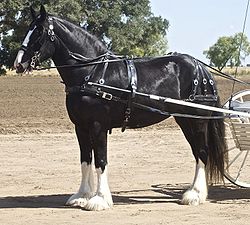 Shire stallions may be black, bay or gray. They may not be roan or have large amounts of white markings. Mares and geldings may be black, bay, gray or roan. In the UK stallions may not be chestnut, but the color is allowed by the US registry. Stallions must stand at least 17 hands (68 inches, 173 cm) high when mature, and they average around 17.2 hands (70 inches, 178 cm). Geldings stand at least 16.2 hands (66 inches, 168 cm) high and mares at least 16 hands (64 inches, 163 cm). The head of a Shire is long and lean, with large eyes, set on a neck that is slightly arched and long in proportion to the body. The shoulder is deep and wide, the chest wide, the back muscular and short and the hindquarters long and wide. There is not to be too much feathering on the legs, and the hair is fine, straight and silky. Smaller Shires, under 17 hands (68 inches, 173 cm), are generally preferred for working horses, while taller horses, especially those over 18.2 hands (74 inches, 188 cm), are used for show and promotional purposes. The breed is known for its easy-going temperament. Shires have been identified to be at risk for chronic progressive lymphedema, a chronic progressive disease that includes symptoms of progressive swelling, hyperkeratosis and fibrosis of distal limbs. The disease is similar to chronic lymphedema in humans.
Shire stallions may be black, bay or gray. They may not be roan or have large amounts of white markings. Mares and geldings may be black, bay, gray or roan. In the UK stallions may not be chestnut, but the color is allowed by the US registry. Stallions must stand at least 17 hands (68 inches, 173 cm) high when mature, and they average around 17.2 hands (70 inches, 178 cm). Geldings stand at least 16.2 hands (66 inches, 168 cm) high and mares at least 16 hands (64 inches, 163 cm). The head of a Shire is long and lean, with large eyes, set on a neck that is slightly arched and long in proportion to the body. The shoulder is deep and wide, the chest wide, the back muscular and short and the hindquarters long and wide. There is not to be too much feathering on the legs, and the hair is fine, straight and silky. Smaller Shires, under 17 hands (68 inches, 173 cm), are generally preferred for working horses, while taller horses, especially those over 18.2 hands (74 inches, 188 cm), are used for show and promotional purposes. The breed is known for its easy-going temperament. Shires have been identified to be at risk for chronic progressive lymphedema, a chronic progressive disease that includes symptoms of progressive swelling, hyperkeratosis and fibrosis of distal limbs. The disease is similar to chronic lymphedema in humans.
The Shire has an enormous capacity for weight pulling. In 1924, at a British exhibition, a pair of horses was estimated to have pulled a starting load equal to 45 tons, although an exact number could not be determined as their pull exceeded the maximum reading on the dynamometer. Working in slippery footing, the same pair of horses pulled 16.5 tons at a later exhibition.
The largest horse in recorded history was probably a Shire named Mammoth, who was born in 1848. He stood 21.2 hands (86 inches, 218 cm) high, and his peak weight was estimated at 1,500 kilograms (3,300 lb). At over 19 hands (76 inches, 193 cm), a Shire gelding named Goliath was the Guinness Book of World Records record holder for the world's tallest horse until his death in 2001.
